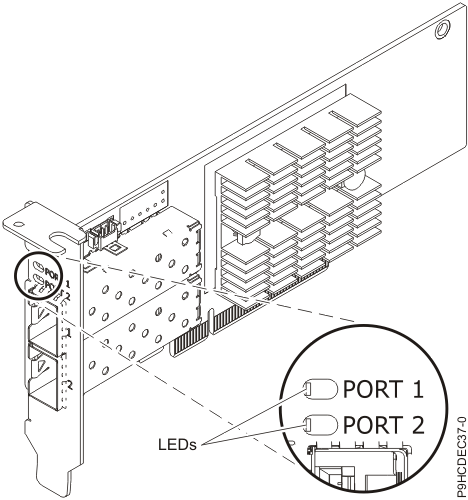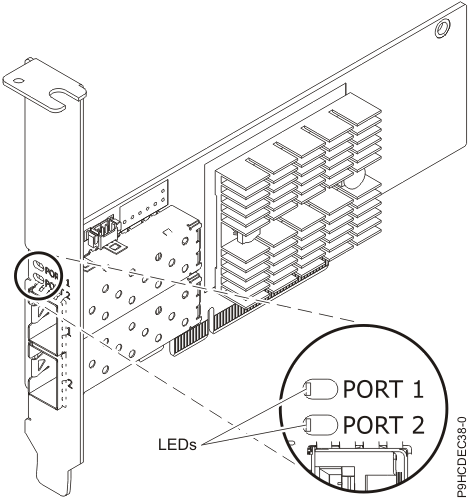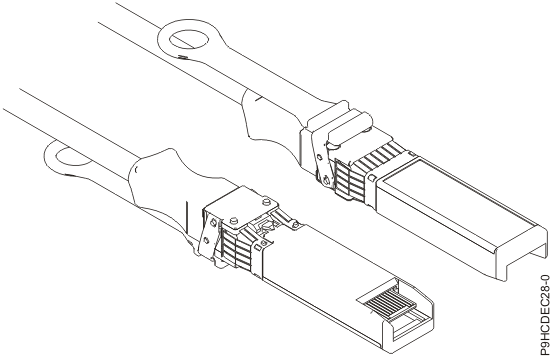PCIe3 2-port 10 GbE NIC & RoCE SFP+ copper adapter (FC EC37, FC EC38, FC EL3X, and FC EL53; CCIN 57BC)
Learn about the specifications and operating system requirements for the feature code (FC) EC37, FC EC38, FC EL3X, and FC EL53 adapters.
Overview
The FC EC37 and FC EL3X are low-profile adapters, and the FC EC38 and FC EL53 are full-height adapters.
The PCIe3 2-Port 10 GbE NIC & RoCE SFP+ adapter is a PCIe generation-3 (PCIe3), dual port, 10 Gigabit Ethernet (GbE) adapter with a PCIe 3.0 host bus interface. The adapter provides two 10 Gb SFP+ ports for copper twinax cabling. These cables also include copper transceivers. The adapter is a converged network adapter supporting both NIC and IBTA RoCE standard. RoCE is Remote Direct Memory Access (RDMA) over Converged Ethernet. Using RoCE, the adapter can support significantly greater bandwidth with low latency and minimize CPU overhead by more efficiently using memory access. This offloads the CPU from I/O networking tasks, improving performance and scalability.
Active Copper twinax cables up to 5 meter in length are supported such as provided by FCs EN01, EN02 or EN03. A copper transceiver is included with these cables. See Cables for details. Each 10 Gb port provides Ethernet connectivity with a nominal data rate of 10 Gbps (gigabits per second).
- The adapter is a PCIe3 NIC network convergence adapter.
- The adapter supports RoCE and NIC functions but not concurrently on same adapter.
- The adapter supports the following standards for the different ports and functions:
- AIX NIM and Linux Network Install are supported
- IBTA RoCE v2 support
- IEEE 802.3ae in the 10 GbE ports
- 802.3ab in the 1 GbE ports
- Ether II and IEEE 802.3 for encapsulated frames
- 802.1p for setting up priority levels in tagged VLAN frames
- 802.1Q for VLAN tagging
- 802.3x for flow control
- 802.3ad for load-balancing and failover
- IEEE 802.3ad and 802.3 for link aggregation
- The adapter provides message signal interrupts (MSI), MSI-X, and support of legacy pin interrupts.
- The adapter supports jumbo frames up to 9.6 KB.
- The adapter supports gigabit EtherChannel (GEC) with the existing software.
- The adapter supports TCP checksum offload transmission control protocol (TCP), user datagram protocol (UDP), TCP segmentation Offload (TSO) for IPv4 and IPv6.
- Supports TCP segmentation or large send offload
- Supports EEPROM-SPI and single EEPROM


Specifications
- Item
- Description
- Adapter FRU number
- 00RX859
- I/O bus architecture
- PCIe3 x8
- Slot requirement
- For details about slot priorities, maximums, and placement rules, see PCIe adapter placement rules and slot priorities and select the system you are working on.
- Voltage
- 3.3 V
- Form factor
- Short
- Cables
- See Cables for details.
Cables

| Cable length | Feature code | CCIN | Part number |
|---|---|---|---|
| 1 m (3.28 ft) | EN01 | EF01 | 46K6182 |
| 3 m (9.84 ft) | EN02 | EF02 | 46K6183 |
| 5 m (16.4 ft) | EN03 | EF03 | 46K6184 |
Operating system or partition requirements
- The latest version of enabling libraries and utilities can be downloaded from the Fix Central website.
- Power Systems Prerequisites website.
- IBM System Storage Interoperation Center (SSIC) website.
- The latest version of the device driver or IBM Power® RAID adapter utilities (iprutils) can be downloaded from the IBM Service and Productivity Tools website.
- For information about important notices for Linux on IBM Power Systems, see the Linux® on IBM website.